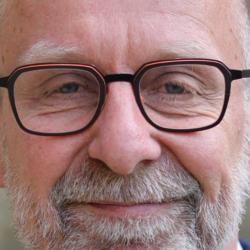I am a molecular immunologist interested in how individual human cells defend themselves against pathogens. Our work is inspired by the remarkable ability of unicellular organisms to resist infections entirely through cell-autonomous defences. We aim to identify fundamental principles of cell-autonomous immunity in mammals and how they work together with professional immune cells. By understanding these mechanisms, we hope to develop novel strategies for preventing and treating infectious diseases.
Research
We are interested in cell autonomous innate immunity, i.e. in the ability of individual cells to defend themselves against infection.
Cytosolic defence against bacterial invasion
The cytosol is rich in nutrients but very few bacteria can colonize it. We wish to understand how cells deploy the ubiquitin system and autophagy to defend their cytosol.
Regulation of NF-kB and IRF signalling
The defence against pathogens requires profound changes in gene expression, which are coordinated by latent transcription factors of the NF-kB and IRF families. We aim to understand how infection activates NF-kB and IRF signalling.
Somatic cell genetics
The genetic analysis of somatic cell lines holds significant potential to our understanding of signal transduction (and other cell autonomous traits). Through homologous recombination and chemical mutagenesis we have obtained a large collection of gene deficient human and murine cells, with which we address problems of cell autonomous innate immunity.
Publications
Boyle, K., Ellison, C., Elliott, Schuschnig, Grimes, Dionne, Sasakawa, Munro, Martens, Randow, F. (2023). TECPR1 conjugates LC3 to damaged endomembranes upon detection of sphingomyelin exposure. EMBO J 42, e113012
Otten, E.G., Werner, E., Crespillo-Casado, A., Boyle, K.B., Dharamdasani, V., Pathe, C., Santhanam, B., and Randow, F. (2021). Ubiquitylation of lipopolysaccharide by RNF213 during bacterial infection. Nature 594, 111–116.
Wandel, M.P., Kim, B.-H., Park, E.-S., Boyle, K.B., Nayak, K., Lagrange, B., Herod, A., Henry, T., Zilbauer, M., Rohde, J., MacMicking, J., Randow, F. (2020). Guanylate-binding proteins convert cytosolic bacteria into caspase-4 signaling platforms. Nat Immunol 21(8):1–12.
Ellison, C.J., Kukulski, W, Boyle, KB, Munro, S., Randow, F. (2020). Transbilayer movement of sphingomyelin precedes catastrophic breakage of enterobacteria-containing vacuoles. Current Biology 30: 1–10.
Ravenhill BJ, Boyle KB, von Muhlinen N, Ellison CJ, Masson GR, Otten EG, Foeglein A, Williams R, Randow F. (2019). The cargo receptor NDP52 initiates selective autophagy by recruiting the ULK complex to cytosol-invading bacteria. Mol Cell 74(2):320-329
Wandel, M., Pathe, C., Werner, E., Ellison, C., Boyle, K., Rohde, J., Randow, F. (2017). GBPs inhibit motility of Shigella flexneri but are targeted for degradation by the bacterial ubiquitin ligase IpaH9.8. Cell Host and Microbe 22, 5-7-518.
Noad, J., Malsburg, von der, A., Pathe, C., Michel, M.A., Komander, D., and Randow, F. (2017). LUBAC-synthesized linear ubiquitin chains restrict cytosol-invading bacteria by activating autophagy and NF-κB. Nat. Microbiol 2, 17063.
Beale, R., Wise, H., Stuart, A., Ravenhill, B.J., Digard, P., and Randow, F. (2014) A LC3-interacting motif in the influenza A virus M2 protein is required to subvert autophagy and maintain virion stability. Cell Host and Microbe 15: 239–247.
Thurston, T.L.M., Wandel, M.P., Muhlinen, von, N., Foeglein, A., and Randow, F. (2012). Galectin 8 targets damaged vesicles for autophagy to defend cells against bacterial invasion. Nature 482, 414–418.
Thurston, T.L., Ryzhakov, G., Bloor, S., von Muhlinen, N. and Randow, F. (2009) The TBK1 adaptor and autophagy receptor NDP52 restricts the proliferation of ubiquitin-coated bacteria. Nat Immunol 10: 1215-1221.
Thurston TL, Boyle KB, Allen M, Ravenhill BJ, Karpiyevich M, Bloor S, Kaul A, Noad J, Foeglein A, Matthews SA, Komander D, Bycroft M, Randow F. (2016) Recruitment of TBK1 to cytosol-invading Salmonella induces WIPI2-dependent antibacterial autophagy.
EMBO J. 35: (16):1779-92.
Randow, F., MacMicking, J.D., and James, L.C. (2013) Cellular self-defense: How cell-autonomous immunity protects against pathogens.
Science 340: 701–706.
Thurston, T.L.M., Wandel, M.P., Muhlinen, Von, N., Foeglein, Á., and Randow, F. (2012) Galectin 8 targets damaged vesicles for autophagy to defend cells against bacterial invasion. Nature 482: 414–418.
Muhlinen, von, N., Akutsu, M., Ravenhill, B.J., Foeglein, A., Bloor, S., Rutherford, T.J., Freund, S.M.V., Komander, D., and Randow, F. (2012) LC3C, Bound Selectively by a Noncanonical LIR Motif in NDP52, Is Required for Antibacterial Autophagy Molecular Cell 48: 329–342.
Bloor, S., Maelfait, J., Krumbach, R., Beyaert, R. and Randow, F. (2010) Endoplasmic reticulum chaperone gp96 is essential for infection with vesicular stomatitis virus. Proc Natl Acad Sci U S A 107: 6970-6975.
Bloor, S., Ryzhakov, G., Wagner, S., Butler, P. J., Smith, D. L., Krumbach, R., Dikic, I., and Randow, F. (2008) Signal processing by its coil zipper domain activates IKK gamma Proc Natl Acad Sci U S A 105: 1279-1284



